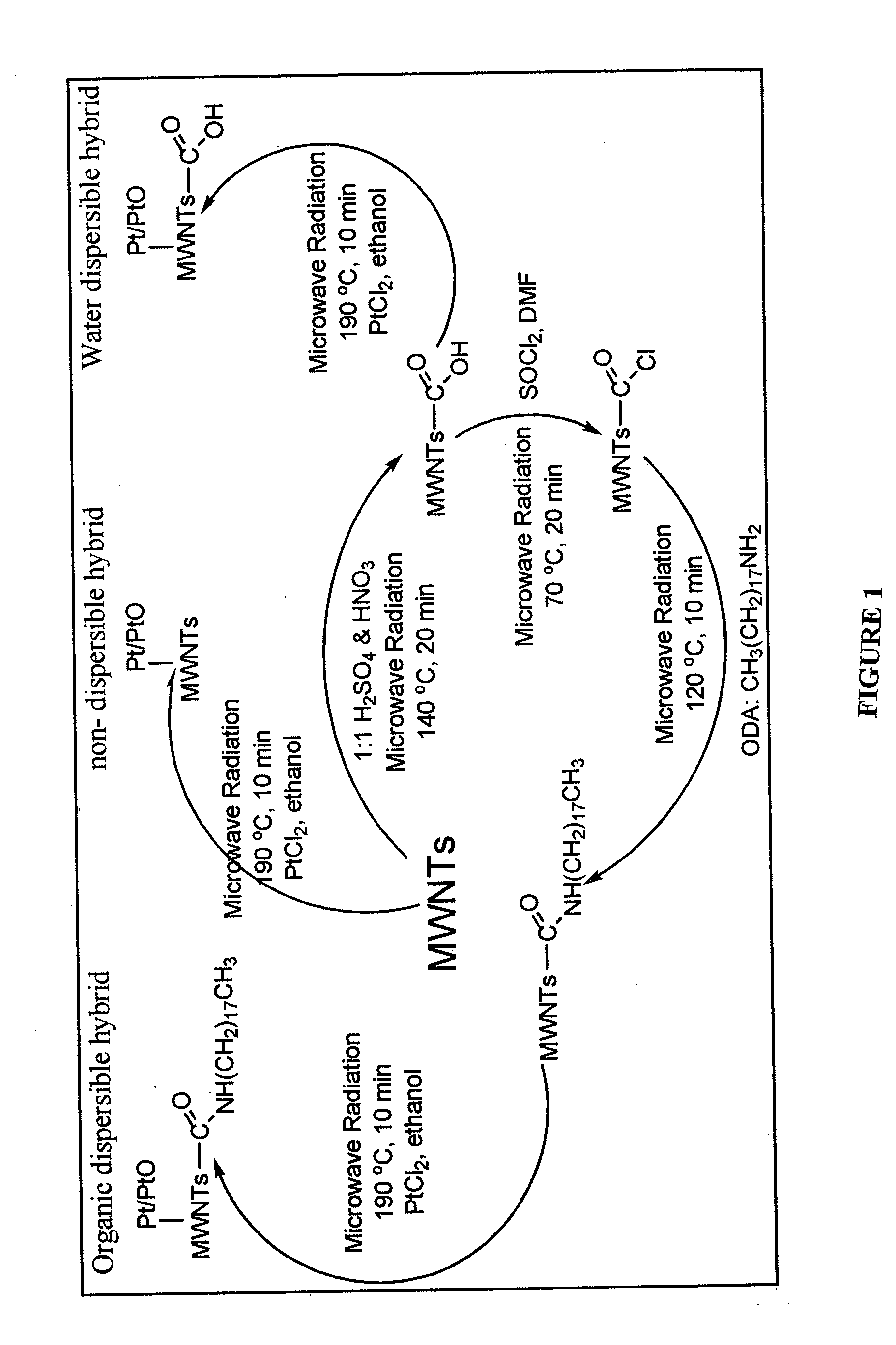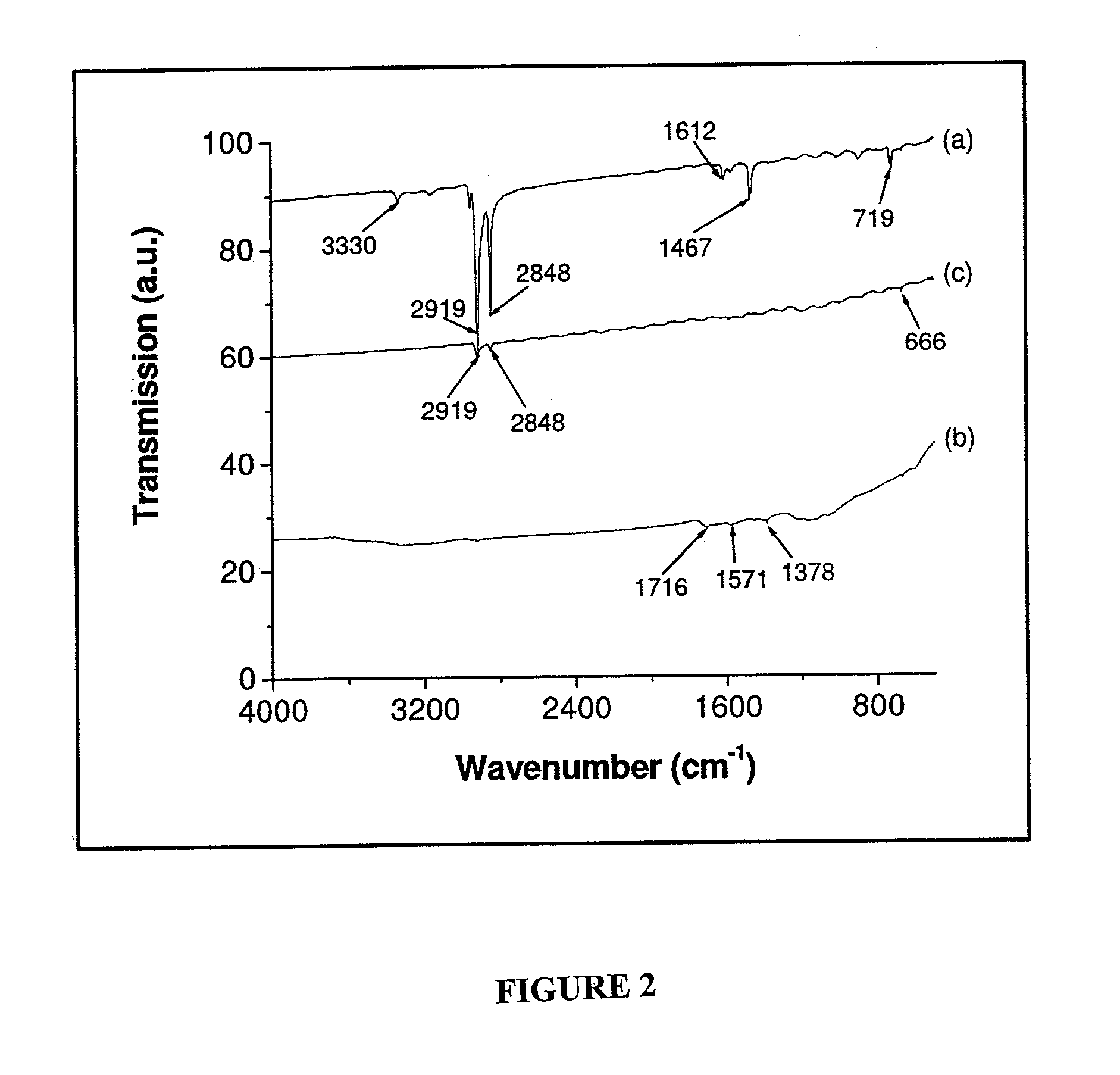Microwave Synthesis of Metal-Carbon Nanotube Composites
a carbon nanotube and composite technology, applied in the field of nanomaterial technology, can solve the problems of difficult dispersibility or dissolution in water or other organic solvents, limited application, and need to be carried out, and achieve the effect of rapid and controllable formation of substantially soluble carbon nanotubes
- Summary
- Abstract
- Description
- Claims
- Application Information
AI Technical Summary
Benefits of technology
Problems solved by technology
Method used
Image
Examples
example 1
Chemicals and Instrumentations
[0067]In exemplary embodiments, MWNTs were purchased from Cheap Tubes Inc. (CAS# 7782-42-5, 95%). The other chemicals were purchased from Sigma Aldrich Inc. The experiments were carried out in a Microwave Accelerated Reaction System (CEM Mars) fitted with internal temperature and pressure controls. The 100 ml reaction chamber was lined with Teflon PFA® with an operating range of about 0° C. to about 200° C., and about 0 psi to about 200 psi. The Fourier Transform Infrared spectroscopy (FTIR) measurements of: (i) the original (e.g., the purchased) MWNTs, (ii) the water soluble w-MWNTs, and (iii) the organic soluble o-MWNTs were carried out in purified KBr pellets using a PerkinElmer (Spectrum One) instrument. The Scanning Electron Microscopy (SEM) was equipped with an energy dispersive X-ray (EDX) analyzer (LEO 1530 VP), and Transmission Electron Microscopy (TEM) (LEO 922 200 kV ultrahigh-resolution microscope) was used for microscopic analysis of the sa...
example 2
Microwave Large-Scale Synthesis of Water Soluble or Dispersible MWNTs
[0068]This exemplary embodiment illustrates a method of rapid synthesis or formation of highly water soluble CNTs (e.g., MWNTs). The microwave functionalized water soluble or dispersible MWNTs (“w-MWNTs”) were prepared in the large scale as per the procedures described above. For example, the experiment included utilizing the CEM Mars Microwave Accelerated Reaction System which was fitted with the internal temperature and pressure controls.
[0069]In a typical reaction, there were seven vessels for balancing the microwave oven, each vessel having about 300 mg original MWNTs added to a reaction chamber along with 25 ml of a mixture of 1:1 concentrated H2SO4 (sulfuric acid) & HNO3 (nitric acid). The reaction vessels were then subjected to microwave radiation around 140° C. for about 10 minutes. After the reaction, the reactants were then transferred into a beaker containing deionized (DI) water and were allowed to cool...
example 3
Microwave Synthesis of Organic-Solvent Soluble or Dispersible MWNTs
[0070]This exemplary embodiment illustrates a method of rapid synthesis or formation of highly organic-solvent soluble or dispersible CNTs (e.g., MWNTs). The microwave synthesized organic-solvent soluble or dispersible MWNTs (“o-MWNTs”) were prepared in the large scale by utilizing the CEM Mars Microwave Accelerated Reaction System which was fitted with the internal temperature and pressure controls.
[0071]In this experiment, the starting material utilized was the previously synthesized, microwave-treated, water soluble w-MWNTs, as discussed above. This starting material was then modified as discussed below. In a typical reaction, two vessels were utilized, each containing about 300 mg of the w-MWNTs added to a reaction chamber together with 25 ml of SOCl2 (thionyl chloride) and about 1 ml dimethylformamide (DMF). Both of the reaction vessels together were then subjected to microwave radiation around 70° C. for about ...
PUM
| Property | Measurement | Unit |
|---|---|---|
| Temperature | aaaaa | aaaaa |
| Temperature | aaaaa | aaaaa |
| Temperature | aaaaa | aaaaa |
Abstract
Description
Claims
Application Information
 Login to View More
Login to View More - R&D
- Intellectual Property
- Life Sciences
- Materials
- Tech Scout
- Unparalleled Data Quality
- Higher Quality Content
- 60% Fewer Hallucinations
Browse by: Latest US Patents, China's latest patents, Technical Efficacy Thesaurus, Application Domain, Technology Topic, Popular Technical Reports.
© 2025 PatSnap. All rights reserved.Legal|Privacy policy|Modern Slavery Act Transparency Statement|Sitemap|About US| Contact US: help@patsnap.com



